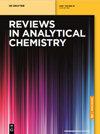吲哚美辛的特征及分析方法综述
IF 3.8
3区 化学
Q2 CHEMISTRY, ANALYTICAL
引用次数: 4
摘要
非甾体类抗炎药(NSAIDs)是治疗风湿性疾病和其他退行性炎症性疾病的首选药物。其中,吲哚美辛(indomethacin, INDO)是本研究的重点。它具有镇痛、解热和抗炎的特性,是用于阻断前列腺素合成机制的各种临床试验和治疗中最有效的药物之一,从而减少和消除患者的许多炎症。为保证该药在制药和临床使用中的有效性和安全性,需要对产品进行精确的质量控制。这种控制是通过使用各种化学方法进行常规药物分析来进行的,通过这些化学方法,INDO被确定为完整药物形式的多组分系统中的单独活性成分。此外,INDO的测定在临床实践中很重要,在临床实践中,INDO的浓度是在不同的生物样品中测定的,从而确保更好地监测特定治疗。最常用的INDO测定方法是高效液相色谱法(已开发方法的37%)、伏安法(已开发方法的16%)和紫外光谱法(已开发方法的11%)。但是,每种方法都必须提供精确的验证参数。多种分析方法的结合可以得到更精确的结果,在实际应用中也更安全。本文章由计算机程序翻译,如有差异,请以英文原文为准。
Review of characteristics and analytical methods for determination of indomethacin
Abstract Nonsteroidal anti-inflammatory drugs (NSAIDs) are the first choice of treatment for rheumatic disorders and other degenerative inflammatory diseases. One of them, indomethacin (INDO), is highlighted in this study. With its analgesic, antipyretic, and anti-inflammatory properties, it is one of the most powerful drugs used in various clinical trials and therapies related to the mechanism of blocking prostaglandin synthesis, thus reducing and eliminating many inflammatory conditions in patients. To ensure the efficacy and safety of this drug in pharmaceutical and clinical use, precise product quality control is required. Such control is performed with routine pharmaceutical analysis using various chemical methods by which INDO is identified as a separate active ingredient in the multicomponent system of a complete pharmaceutical form. In addition, the determination of INDO is important in clinical practice, where its concentration is determined in different biological samples, ensuring better monitoring of a particular therapy. The most commonly used methods for the determination of INDO are high-performance liquid chromatography (37% of developed methods), voltammetry (16% of developed methods), and UV spectroscopy (11% of developed methods). However, each of these methods must provide precise validation parameters. A combination of analytical methods can lead to more precise results and safer application in practice.
求助全文
通过发布文献求助,成功后即可免费获取论文全文。
去求助
来源期刊

Reviews in Analytical Chemistry
化学-分析化学
CiteScore
7.50
自引率
0.00%
发文量
15
审稿时长
>12 weeks
期刊介绍:
Reviews in Analytical Chemistry publishes authoritative reviews by leading experts in the dynamic field of chemical analysis. The subjects can encompass all branches of modern analytical chemistry such as spectroscopy, chromatography, mass spectrometry, electrochemistry and trace analysis and their applications to areas such as environmental control, pharmaceutical industry, automation and other relevant areas. Review articles bring the expert up to date in a concise manner and provide researchers an overview of new techniques and methods.
 求助内容:
求助内容: 应助结果提醒方式:
应助结果提醒方式:


